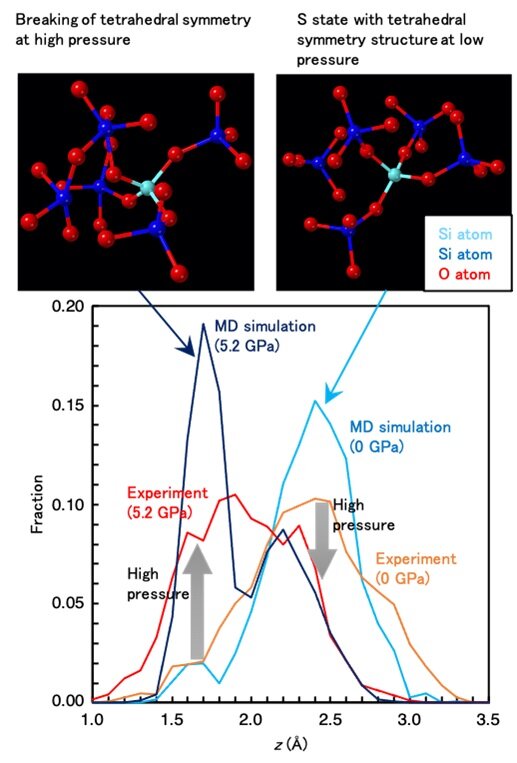Structural origin of the anomalous properties of SiO2 glass under pressure


Understanding the structural origin of the anomalous properties of SiO2 liquid and glass is fundamental not only in physics, but also in geophysics, in understanding the nature of silicate magmas in the Earth and other planets, and in materials science as a prototype network-forming glass. Theoretical studies of SiO2 liquid suggest that the second shell structure of silicon is the key to understanding the anomalous properties of SiO2 liquid at high temperatures and high pressures.
A structural parameter z (z=dji– dj’i, where dji and dj’i is the distance from each silicon atom i to the fifth nearest silicon neighbor j and to the fourth nearest oxygen neighbor j’) was developed to investigate the second shell structure in SiO2 liquid. Published in Nature Communications, the theoretical study found a bimodal distribution in the structural parameter z with varying temperatures, and the S and r states are assigned to the high and low distributions in the parameter z, respectively. The low-density S state in SiO2 liquid consists of four silicon neighbor atoms in the first shell and exhibits high tetrahedral order with clear separation between the first and second shell. On the other hand, the r state has more silicon neighbor atoms in the first shell and shows lower tetrahedral order than the S state.
The fraction of the S state with high tetrahedrality is considered to be the controlling parameter of the anomalous properties of SiO2 liquid at high temperatures and high pressures in theoretical studies. However, there has been no experimental observation of the structure of the silicon’s second shell in SiO2 liquid and/or glass at high temperature and/or high pressure conditions.
In this work, we carried out in situ high-pressure pair distribution function measurement of SiO2 glass by utilizing high flux and high energy X-rays from undulator sources at BL37XU and BL05XU beamlines in SPring-8. By combining the high-pressure experimental structure factor [S(Q)] precisely determined by using monochromatic X-ray at a wide range of Q up to 19-20 Å-1 with the MD (molecular dynamics simulation)-RMC (reverse Monte Carlo) modeling, we were able to investigate in detail the structural behavior of SiO2 glass beyond the nearest neighbor distances under in situ high pressure conditions. We found bimodal features in the translational order of the silicon’s second shell in terms of the structural parameter z.
The bimodal behavior in the distribution of the parameter z observed in SiO2 glass with varying pressure in this study is consistent with that simulated in SiO2 liquid with varying temperatures in the theoretical study. The structure of SiO2 glass with the characteristic distribution of the parameter z at 2.4–2.7 Å shows that a tetrahedral symmetry structure formed from the nearest four silicon atoms in the first shell, and the first and second shells are clearly separated as the fifth neighbor silicon atom locates in the second shell. The structural feature corresponds to the low-density S state structure reported in the theoretical study of SiO2 liquid.
On the other hand, the structure of SiO2 glass with the characteristic distribution of z at 1.7 Å shows that the fifth neighbor silicon atom locates in the first shell, which indicates collapse of the silicon’s second shell onto the first shell and the breaking of the local tetrahedral symmetry in SiO2 glass under pressure, as well as theoretical observation in SiO2 liquid at high temperatures and high pressures.
Breaking local symmetry—why water freezes but silica forms a glass
Yoshio Kono et al, Experimental evidence of tetrahedral symmetry breaking in SiO2 glass under pressure, Nature Communications (2022). DOI: 10.1038/s41467-022-30028-w
Provided by
Ehime University
Citation:
Structural origin of the anomalous properties of SiO2 glass under pressure (2022, June 27)
retrieved 27 June 2022
from https://phys.org/news/2022-06-anomalous-properties-sio2-glass-pressure.html
This document is subject to copyright. Apart from any fair dealing for the purpose of private study or research, no
part may be reproduced without the written permission. The content is provided for information purposes only.
For all the latest Science News Click Here
For the latest news and updates, follow us on Google News.

